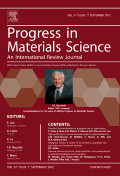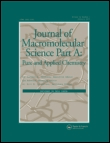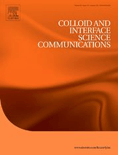
ADVANCES IN COLLOID AND INTERFACE SCIENCE
Scope & Guideline
Advancing Understanding of Interfacial Phenomena
Introduction
Aims and Scopes
- Colloidal Stability and Interfacial Phenomena:
Research on the stability of colloidal systems, including the mechanisms of stabilization and destabilization, as well as the dynamics of interfacial phenomena such as adsorption, wetting, and spreading. - Nanomaterials and Their Applications:
Focus on the synthesis, characterization, and application of nanomaterials in various domains, including drug delivery, environmental remediation, and catalysis. - Biomaterials and Biomedical Applications:
Investigation of colloidal systems in biomedical contexts, such as drug delivery systems, antimicrobial agents, and tissue engineering, emphasizing the interaction between biomaterials and biological systems. - Environmental Colloids and Interfaces:
Studies related to the role of colloids in environmental processes, including pollutant transport, adsorption, and the behavior of colloidal systems in natural waters. - Emerging Technologies in Colloid Science:
Exploration of innovative applications and technologies in colloid and interface science, including 3D printing, smart materials, and responsive systems.
Trending and Emerging
- Sustainable Nanomaterials:
Growing emphasis on the development and application of sustainable nanomaterials, including biodegradable options and those derived from renewable resources, particularly in the context of environmental and health applications. - Smart and Responsive Colloidal Systems:
Increased focus on the design and application of smart materials that can respond to external stimuli, such as pH, temperature, and light, particularly in biomedical and environmental applications. - Advanced Characterization Techniques:
A trend towards using advanced characterization methods, such as atomic force microscopy and neutron scattering, to better understand the structural and dynamic properties of colloidal systems. - Interfacial Engineering for Enhanced Performance:
Research dedicated to engineering interfacial properties to improve the performance of materials in various applications, including coatings, catalysis, and drug delivery systems. - Colloidal Systems in Food Science:
Emerging interest in the application of colloid science in food technology, including the stabilization of food emulsions, encapsulation of flavors, and the development of delivery systems for nutrients.
Declining or Waning
- Traditional Surfactants in Oil Recovery:
Research on conventional surfactants for enhanced oil recovery has decreased in favor of more sustainable and innovative alternatives, such as biosurfactants and green chemistry approaches. - Classical Theories of Surface Tension:
The reliance on classical models of surface tension and wetting has waned as newer, more complex theories and experimental techniques provide deeper insights into interfacial phenomena. - Static Emulsification Techniques:
There is a noticeable reduction in studies focusing solely on static emulsification techniques, as dynamic and advanced methodologies are increasingly preferred for their efficiency and applicability in various industries.
Similar Journals

Soft Matter
Advancing Knowledge in Soft Matter DynamicsSoft Matter, published by the Royal Society of Chemistry, stands as a premier journal in the interdisciplinary field of soft matter science, encompassing studies in materials that are neither entirely solid nor liquid, such as polymers, colloids, and biological materials. With an impressive impact factor indicative of its relevance and citation frequency, Soft Matter has secured a notable position in the academic community, achieving Q1 status in both Chemistry (miscellaneous) and Condensed Matter Physics in 2023. It ranks #102 out of 434 in Condensed Matter Physics and #114 out of 408 in General Chemistry, placing it firmly in the 76th and 72nd percentiles respectively. Since its inception in 2005, the journal has dedicated itself to advancing the understanding of soft materials through high-quality research articles, reviews, and technical notes. Its comprehensive scope invites contributions from both fundamental and applied perspectives, making it an essential resource for researchers, professionals, and students alike. Access to cutting-edge findings and innovative methodologies in this rapidly evolving field is critical for fostering new discoveries and applications, underscoring the journal's vital role in the academic discourse.

CURRENT OPINION IN COLLOID & INTERFACE SCIENCE
Exploring Innovations in Surface Chemistry and BeyondCURRENT OPINION IN COLLOID & INTERFACE SCIENCE, published by Elsevier Science London, serves as a premier platform for researchers and professionals in the field of colloid, interface science, and related disciplines. With an impressive Q1 ranking in multiple categories including Colloid and Surface Chemistry, Physical and Theoretical Chemistry, Polymers and Plastics, as well as Surfaces and Interfaces, this journal showcases cutting-edge developments and expert opinions that drive innovation in these areas. As a leader in its field, it maintains robust academic standards, reflected in its high percentile rankings across various Scopus categories, such as 3rd in Surfaces and Interfaces and 10th in Physical and Theoretical Chemistry. While the journal is not Open Access, it provides valuable insights to a wide audience, making it an essential resource for advancing knowledge and fostering collaborations among researchers, academics, and industry professionals alike. With a continual publication timeline extending from 1996 to 2024, it captures the evolving landscape of colloid and interface science, ensuring that readers are equipped with the latest findings and perspectives.

PROGRESS IN MATERIALS SCIENCE
Exploring the Frontiers of Material InnovationPROGRESS IN MATERIALS SCIENCE is an esteemed peer-reviewed journal published by Pergamon-Elsevier Science Ltd, focusing on pioneering advancements and comprehensive studies in the field of Materials Science. With an ISSN of 0079-6425 and an E-ISSN of 1873-2208, this journal boasts a prestigious status, ranking in the Q1 category for Materials Science (miscellaneous) and achieving a remarkable 99th percentile in Scopus rankings, positioned 4th out of 463 journals in General Materials Science. Published from the United Kingdom, PROGRESS IN MATERIALS SCIENCE provides critical insights into the latest discoveries, trends, and methodologies shaping the materials science landscape, making it an invaluable resource for researchers, professionals, and students alike. Readers can explore rich content on subjects ranging from nanomaterials to biomaterials and beyond, all designed to foster innovation and knowledge dissemination in the materials science community. Although it is not an open-access journal, it remains a pivotal platform for high-quality research and essential discourse in this dynamic field.

Journal of Macromolecular Science Part A-Pure and Applied Chemistry
Bridging Theory and Application in Macromolecular ScienceWelcome to the Journal of Macromolecular Science Part A - Pure and Applied Chemistry, a distinguished publication dedicated to advancing the understanding of macromolecular science, encompassing critical areas such as polymers, materials chemistry, and composites. Published by Taylor & Francis Inc, this journal has firmly established its place within the scientific community, evident from its ranking in the Q2 and Q3 quartiles across various categories in the latest assessments, including Polymers and Plastics as well as Ceramics and Composites. With a commitment to providing high-quality peer-reviewed content, the journal aims to facilitate knowledge exchange and innovation among researchers and practitioners from around the globe. The absence of open access underscores the journal's commitment to maintaining rigorous editorial standards while remaining accessible to its readership. As the journal converges through valuable research contributions from 1992 to 2024, it continues to be a pivotal resource for professionals and students seeking to explore the latest advancements and applications in the field of macromolecular science.

ACS Materials Letters
Innovative Insights for Tomorrow's TechnologiesACS Materials Letters is an esteemed peer-reviewed journal published by the American Chemical Society, emphasizing groundbreaking research and advancements in the fields of materials science, biomedical engineering, and chemical engineering. With a robust update and established reputation since its inception in 2019, this journal has rapidly ascended to the top tiers, achieving Q1 rankings in key categories such as Biomedical Engineering, Chemical Engineering (miscellaneous), and Materials Science (miscellaneous) in 2023. The journal boasts impressive Scopus rankings, including #14 in General Chemical Engineering and #19 in Biomedical Engineering, placing it among the elite publications in these domains. While not fully open access, ACS Materials Letters facilitates the dissemination of high-impact research accessible to academics and industry professionals alike. With its comprehensive scope and rigorous selection process, the journal serves as a vital resource for researchers and students eager to stay abreast of the latest innovations and technologies shaping materials science and engineering.

Gels is a distinguished, peer-reviewed journal published by MDPI, focusing on the innovative field of gels and their myriad applications across disciplines such as bioengineering, biomaterials, and organic chemistry. Since its inception in 2015, this Open Access journal has provided a platform for researchers to disseminate cutting-edge findings, enabling wider visibility and impact for their work. Based in Switzerland, Gels has firmly established itself within the academic community, achieving notable recognition as evidenced by its recent Q1 ranking in Polymers and Plastics, and multiple Q2 placements in related categories, demonstrating its relevance and importance in the field. The journal serves as a vital resource for professionals and scholars aiming to engage with the rapidly evolving research landscape surrounding gel technologies, making significant contributions to sustainable materials, drug delivery systems, and much more. With its commitment to Open Access, Gels ensures that research findings are readily accessible to all stakeholders, fostering collaboration and advancement in science and engineering fields.

COLLOIDS AND SURFACES A-PHYSICOCHEMICAL AND ENGINEERING ASPECTS
Innovating Solutions Through Interdisciplinary ResearchCOLLOIDS AND SURFACES A-PHYSICOCHEMICAL AND ENGINEERING ASPECTS is a prestigious journal published by Elsevier, focusing on the interdisciplinary domains of colloid and surface chemistry, physical and theoretical chemistry, and engineering aspects. With an impressive impact factor and consistently high rankings—Q2 in Colloid and Surface Chemistry, and Q1 in both Physical and Theoretical Chemistry as well as Surfaces and Interfaces—it stands as a vital resource for researchers and professionals seeking to advance their understanding in these critical areas of study. Established in 1993, the journal spans over three decades of publication, gathering robust interdisciplinary insights that cater to both fundamental research and practical applications. While the journal is not currently open access, it remains an essential platform for disseminating innovative studies that explore the physicochemical properties of colloidal systems and surface interactions. Based in the Netherlands, the journal actively encourages contributions that enhance the scientific community’s knowledge and application of these complex phenomena, making it an indispensable tool for students and professionals alike in their quest for cutting-edge advancements.

ADVANCED FUNCTIONAL MATERIALS
Advancing Knowledge in Biomaterials and NanotechnologyADVANCED FUNCTIONAL MATERIALS is a leading journal published by WILEY-V C H VERLAG GMBH, prominently recognized in the fields of biomaterials, chemistry, condensed matter physics, and materials science. With an impressive impact factor and a distinguished position in the Q1 quartile across multiple categories including nanoscience and nanotechnology, this journal serves as a vital platform for researchers and professionals committed to innovating in functional materials. Since its inception in 2000, ADVANCED FUNCTIONAL MATERIALS has published high-quality peer-reviewed articles that push the boundaries of materials science, exploring new frontiers in electronic, optical, and magnetic materials. The journal's dedication to open access ensures that its groundbreaking findings are readily available to a global audience, fostering collaboration and knowledge-sharing among scholars and practitioners in the field. For those seeking to stay at the forefront of materials research, ADVANCED FUNCTIONAL MATERIALS is an essential resource.

Colloids and Interfaces
Transforming Knowledge in Colloid ScienceColloids and Interfaces is a cutting-edge open access journal published by MDPI based in Switzerland, focusing on innovative research in the fields of colloid and surface chemistry. Established in 2017, this journal has quickly become a significant platform for sharing critical insights and advancements within the discipline, maintaining a commendable impact factor that reflects its scholarly importance. With a Q2 ranking in miscellaneous chemistry and a Q3 rank in colloid and surface chemistry, it stands as a vital resource for researchers and professionals dedicated to the study of colloidal phenomena. The journal's open access policy, initiated in 2018, ensures that findings are readily available to a global audience, fostering collaboration and innovation. As it continues to converge research until 2024, Colloids and Interfaces is positioned to further enhance the burgeoning field of colloidal science.

Colloid and Interface Science Communications
Unveiling Breakthroughs in Surface PhenomenaColloid and Interface Science Communications is a prestigious peer-reviewed journal published by Elsevier, specializing in the vibrant fields of colloid and surface science, along with biotechnology. With an impressive open access policy initiated in 2022, this journal ensures wide dissemination of groundbreaking research. Its impact is reflected in its high standings within various Scopus category quartiles—ranked Q2 in Biotechnology and Colloid and Surface Chemistry, and Q1 in Materials Chemistry, Physical and Theoretical Chemistry, as well as Surfaces, Coatings and Films for 2023. Furthermore, it boasts exceptional Scopus rankings, including a top percentile position in several materials science categories, indicating its significant contribution to the scientific community. Published in the Netherlands, Colloid and Interface Science Communications aims to foster knowledge sharing and collaboration by providing a platform for innovators and researchers to explore cutting-edge developments in surface phenomena and materials interactions. As a key resource for researchers, professionals, and students alike, it plays a critical role in advancing our understanding and application of colloidal and interface science.